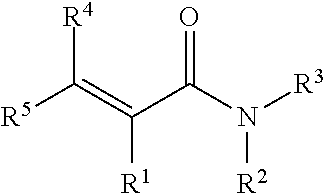Binder aqueous solution for lithium-ion battery, slurry for lithium-ion battery negative electrode, negative electrode for lithium-ion battery, and lithium-ion battery
a technology of lithium-ion batteries and binders, which is applied in the direction of cell components, electrochemical generators, impregnation manufacturing, etc., can solve the problems of lithium-ion batteries using the above electrodes being likely to deteriorate in electrical characteristics such as cycle characteristics, and the electrodes for lithium-ion batteries are likely to expand and contract, etc., to achieve excellent flexibility and adhesion, excellent storage stability, and excellent storage stability
- Summary
- Abstract
- Description
- Claims
- Application Information
AI Technical Summary
Benefits of technology
Problems solved by technology
Method used
Image
Examples
preparation example 1
[0171]In a reactor equipped with a stirrer, a thermometer, a reflux condenser and a nitrogen gas introduction pipe, 1,240 g of ion-exchanged water, 350 g (2.46 mol) of 50% acrylamide aqueous solution, 56.6 g (0.43 mol) of 2-methoxyethyl acrylate, and 0.23 g (0.0014 mol) of sodium methallyl sulfonate were put, and after oxygen in the reaction system was removed through nitrogen gas, the resultant was heated to 55° C. 2.1 g of 2,2′-azobis-2-amidinopropane dihydrochloride (product name “NC-32” made by NIPPOH CHEMICALS CO., LTD.) and 20 g of ion-exchanged water were put therein, and the resultant was heated to 80° C. and reacted for 3 hours. Ion-exchanged water was added so as to achieve a solid content concentration of 13%, and a binder aqueous solution containing a water-soluble poly(meth)acrylamide was obtained. The B-type viscosity of this solution at 25° C. was 10,000 mPa·s.
[0172]In Preparation Examples 2 to 4, a binder aqueous solution containing a water-soluble poly(meth)acrylami...
preparation example 5
[0173]In a reactor equipped with a stirrer, a thermometer, a reflux condenser and a nitrogen gas introduction pipe, 1,170 g of ion-exchanged water, 120 g (0.84 mol) of 50% acrylamide aqueous solution, 12 g (0.12 mol) of N,N-dimethylacrylamide, 62.8 g (0.48 mol) of 2-methoxyethyl acrylate, 87 g (0.96 mol) of 80% acrylic acid and 0.19 g (0.0012 mol) of sodium methallyl sulfonate were put, and after oxygen in the reaction system was removed through nitrogen gas, the resultant was heated to 55° C. 1.8 g of 2,2′-azobis-2-amidinopropane dihydrochloride (product name “NC-32” made by NIPPOH CHEMICALS CO., LTD.) and 20 g of ion-exchanged water were put therein, and the resultant was heated to 80° C. and reacted for 3 hours. After that, 64.4 g (0.77 mol) of 48% sodium hydroxide aqueous solution as a neutralizer was added and stirred, ion-exchanged water was added so as to achieve a solid content concentration of 13%, and a binder aqueous solution containing a water-soluble (meth)polyacrylamid...
example 1
[0180]A slurry was prepared using a commercially available homodisper (“Homodisper Model 2.5” made by PRIMIX Corporation). In a mayonnaise bottle as a container, the binder aqueous solution for a lithium-ion battery as obtained in Preparation Example 1, which contained the water-soluble poly(meth)acrylamide (A), was mixed in an amount of 5 parts by mass in terms of solid content with 20 parts by mass of silicon monoxide particles (“CC Powder” made by OSAKA Titanium technologies Co., Ltd.) having a D50 (median diameter) of 5 μm, 80 parts by mass of artificial graphite (“G1-A#” made by Jiangxi Zichen Technology Co., Ltd.) having a D50 (median diameter) of 20 μm, and 1 part by mass of a conductive aid (“Super C65” made by Imerys Graphite & Carbon Japan K.K.). Ion-exchanged water was added thereto so as to achieve a solid content concentration of 47%, and the container was set in the above homodisper. Next, the resultant was kneaded at 3,000 rpm for 10 minutes. After that, the resultant...
PUM
| Property | Measurement | Unit |
|---|---|---|
| mol % | aaaaa | aaaaa |
| water-soluble | aaaaa | aaaaa |
| mol % | aaaaa | aaaaa |
Abstract
Description
Claims
Application Information
 Login to View More
Login to View More - R&D
- Intellectual Property
- Life Sciences
- Materials
- Tech Scout
- Unparalleled Data Quality
- Higher Quality Content
- 60% Fewer Hallucinations
Browse by: Latest US Patents, China's latest patents, Technical Efficacy Thesaurus, Application Domain, Technology Topic, Popular Technical Reports.
© 2025 PatSnap. All rights reserved.Legal|Privacy policy|Modern Slavery Act Transparency Statement|Sitemap|About US| Contact US: help@patsnap.com

